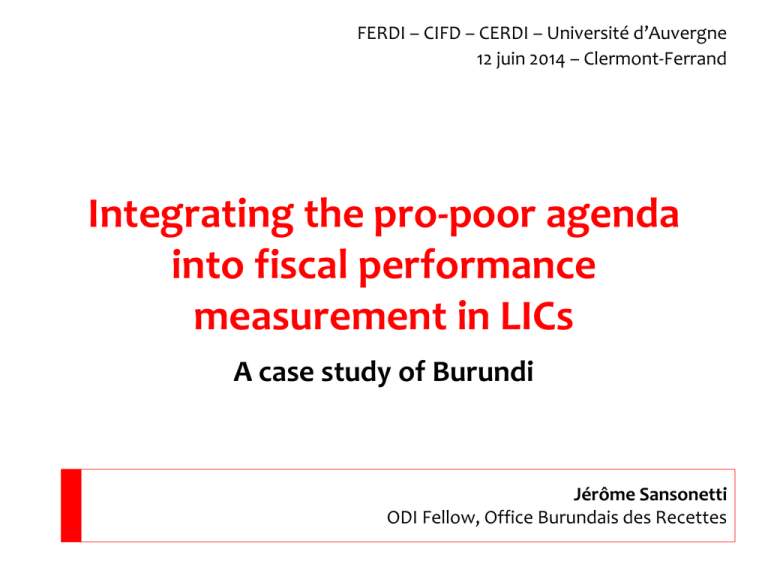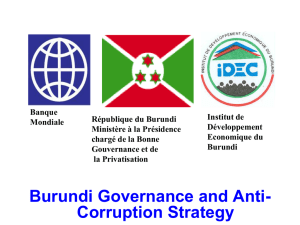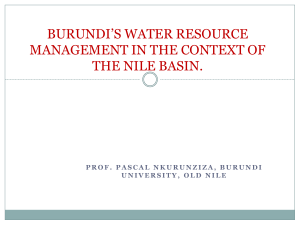2. Burundi: tax side
advertisement

FERDI – CIFD – CERDI – Université d’Auvergne 12 juin 2014 – Clermont-Ferrand Integrating the pro-poor agenda into fiscal performance measurement in LICs A case study of Burundi Jérôme Sansonetti ODI Fellow, Office Burundais des Recettes Introduction Linking revenue and poverty reduction 2 Introduction Linkages between tax and poverty o In a country like Burundi, the pro-poor agenda is rarely included in fiscal monitoring schemes o Poverty reduction remains a central policy objective • o Fiscal performance should be measured and designed in a way that monitors propoor impact Surprising, as it is a challenge to mobilize revenues in LICs 3 Introduction Linkages between tax and poverty o The linkages between revenue reforms and poverty reduction are not appreciated at every echelon on the ground o There is no direct link between revenue increase and poverty reduction Increased revenues Progressive taxes Pro-poor spending tax side spending side Poverty reduction Pro-poor impact Worst-case scenario? 4 Introduction Increased risk of regressivity in LICs o LICs feature of higher risk of regressivity, all other things equal • • o Tax progressivity: • o Narrow income tax bases Large returns to capital (classical growth theory) A tax is progressive if the tax payments of richer households accounts for a larger proportion of their incomes than those of poorer households Consumption taxes with a flat rate can be regressive • Poorer households consume a larger fraction of their incomes 5 Introduction Research questions 1. Do revenue reforms in LICs incur regressivity? o The nature of the linkages is not fully appreciated o Raising revenues does incur a risk of regressivity 2. Are fiscal performance indicators fitted to monitor pro-poor impact? o Indicators used in LICs fall short 6 Outline Introduction – the linkages between revenue mobilization and poverty reduction 1. Literature review 2. Case of Burundi: tax side 3. Case of Burundi: spending side 4. Suggested indicators 7 Section 1 Literature review 8 1. Literature review 2. Burundi: tax side 3. Burundi: spending 4. Suggested indicators Overall fiscal structure in LICs IFI consensus Strengthen VAT revenues Reduce trade taxes Reduce corporate rate 9 1. Literature review 2. Burundi: tax side 3. Burundi: spending 4. Suggested indicators VAT o IFI consensus (IMF FAD, 2011) • • • Broad-based: few exemptions Single rate High registration threshold Regressivity o o Progressivity In South Africa, poorest deciles feature higher VAT burden (Go et al., 2005) o Average number of VAT rates o (IMF FAD, 2011) • • LICs: 1,28 Rich countries: 2,52 VAT less regressive than former sales taxes (Zolt & Bird, 2005) More efficient to treat progressivity on spending side than by relaxing VAT • Case of Chile (Engel et al. 1999) 10 1. Literature review 2. Burundi: tax side 3. Burundi: spending 4. Suggested indicators Trade taxes o IFI consensus: reduce import duties and trade taxes (Marshall, 2009) • • 1980s: 4% - 5% of GDP Late 2000s: 3% of GDP Regressivity o Export taxes are arguably progressive, so removal is regressive o Replacement with VAT creates aforementioned issues Progressivity o Removing import taxes is progressive if poor households consume a larger fraction of imports o In South Africa, trade liberalization was found to be progressive (Daniels & Edwards, 2006) 11 1. Literature review 2. Burundi: tax side 3. Burundi: spending 4. Suggested indicators Corporate income tax o IFI consensus (Marshall, 2009) • • Decrease statutory rates to attract investors Effect of Doing Business Indicators for “paying taxes” Regressivity o Decrease in statutory rates in SSA (Keen & Mansour, 2009) • • o 1990: 44% 2005: 33% Progressivity o General equilibrium effect after tax shifting can be progressive (Harberger, 1962) Increase in exemptions in SSA (Keen & Mansour, 2009) • • 1980: 40% 2005: 80% 12 Section 2 Burundi – tax side 13 1. Literature review 2. Burundi: tax side 3. Burundi: spending 4. Suggested indicators Burundi’s tax reforms since 2009 Tax administration o Creation of a Revenue Authority in 2010 (OBR) • • • Compliance Taxpayer services IT systems Tax policy o VAT created (2009) o VAT reform (2013) • • o Corporate income tax (2013) • o More exemptions Intermediary rate at 10% Statutory rate reduced from 35% to 30% Personal income tax (2013) • • Threshold increased Statutory rates decreased 14 1. Literature review 2. Burundi: tax side 3. Burundi: spending 4. Suggested indicators Burundi’s tax reforms since 2009 Burundi's total tax revenues 600 30% 559,51 526,64 500 471,71 BIF bn 450 400 25% 20% 16,29% 13,66% 15,08% 14,14% 14,12% 15% 362,76 350 300 Tax/GDP 550 10% 301,21 5% 250 200 0% 2009 2010 2011 OBR collection (A) 2012 2013 Tax/GDP 15 1. Literature review 2. Burundi: tax side 3. Burundi: spending 4. Suggested indicators Overall distributional impact As % of collection 2010 Taxes on revenues, profits and capital gains 2011 2012 2013 2010 2011 2012 2013 30,0% 26,6% 29,6% 25,7% 4,2% 4,3% 4,5% 3,6% Total personal income taxes Total corporate income taxes 11,7% 10,7% 12,7% 7,7% 14,3% 14,7% 15,7% 16,9% Taxes on goods and services 53,4% 53,9% 54,3% 58,8% VAT (domestic + customs) Excise (domestic and customs) 36,5% 36,5% 36,5% 37,7% 16,0% 14,5% 15,3% 19,6% Tax on international trade and transactions Import duties Export taxes Non-fiscal products TOTAL REVENUES As % of GDP 10,8% 12,5% 9,4% 8,2% 0,0% 5,8% 8,4% 0,0% 7,0% 8,3% 0,0% 6,6% 9,0% 7,5% 0,1% 6,5% 100% 100% 100% 100% 1,6% 2,0% 7,6% 5,2% 2,3% 1,5% 1,2% 0,0% 0,8% 1,7% 2,4% 8,8% 5,9% 2,4% 2,0% 1,4% 0,0% 1,1% 1,9% 2,4% 8,2% 5,5% 2,3% 1,4% 1,3% 0,0% 1,0% 1,1% 2,4% 8,3% 5,3% 2,8% 1,3% 1,1% 0,0% 0,9% 14,1% 16,3% 15,1% 14,1% 16 1. Literature review 2. Burundi: tax side 3. Burundi: spending 4. Suggested indicators Data available to assess regressivity o QUIBB 2006: expenditure survey, household level o Construct a “total expenditure” variable • • o 77 food and non-food expenses Only health and education missing Quartiles of wealth based on syncretic wealth score Weighted aver. total exp. (BIF/year) Weighted aver. total exp. (USD/year) Quartile 1 178 946 119 Quartile 2 231 798 155 Total observations Well surveyed observations Observations for total exp. (BIF/mois) Quartile 3 293 304 196 Quartile 4 898 268 599 7832 7042 5812 17 1. Literature review 2. Burundi: tax side 3. Burundi: spending VAT – exemptions Financial operations Insurance operations International transportation Piped water and electricity private consumption Post stamps Rental of unfurnished private housing Minibus transportation (14+ seats) Health care School and higher education material Untransformed agricultural goods Piped water consumed by HH Electricity consumed by HH Housing rental Travels and transportation Post services 4. Suggested indicators Exempted? Impact of Pre-2013 Post-2013 exemption Yes Yes Regressive Yes Yes Regressive Yes Yes Regressive No Yes Regressive Yes Yes Regressive Yes Yes Regressive No Yes Regressive Yes Yes Regressive Yes Yes Progressive Yes Yes Progressive Quartile 1 Quartile 2 Quartile 3 Quartile 4 0,03% 0,06% 0,07% 0,23% 0,02% 0,004% 0,04% 0,16% 0,07% 0,09% 0,16% 0,97% 0,40% 0,70% 1,13% 2,12% 0,01% 0,02% 0,01% 0,04% 1. Literature review 2. Burundi: tax side 3. Burundi: spending 4. Suggested indicators VAT – intermediary rate o A 10% intermediary rate was implemented on 12 staple foods • Cassava, maize, wheat, etc… Products taxed at 10% Quartile 1 Quartile 2 Quartile 3 Quartile 4 52,02% 44,84% 42,34% 33,83% o Direct effect is progressive o Indirect effect is unclear, as retailers may not have shifted the VAT decrease • • Inflation for 10%-taxed staples (Jul.-Dec. 2013): 1.75% Inflation for other food items (Jul.-Dec. 2013): -1.69% 19 1. Literature review 2. Burundi: tax side 3. Burundi: spending 4. Suggested indicators Excise o A 10% intermediary rate was implemented on 12 staple foods Bottled water Import of old vehicle (BIF) Sodas (BIF/hL) Beer (BIF/hL) Sugar (BIF/Kg) Wine and liquors Tobacco Fuel (BIF/L) Sodas Beer & alcoholic drinks Sugar Tobacco Fuel 2010 0 0 18 000 17 820 400 50% 83% NA 2011 18 000 19 049 165 2012 2013 10% 10% 1 500 000 1 500 000 30 000 30 000 36 000 36 000 400 600 70% 70% 120% 200% 24 21 Impact? Progressive Progressive Progressive Progressive Progressive Progressive Regressive Regressive Quartile 1 Quartile 2 Quartile 3 Quartile 4 0,22% 0,23% 0,31% 0,73% 0,30% 0,55% 0,96% 2,21% 0,49% 0,71% 0,69% 1,63% 1,21% 1,31% 1,12% 0,64% 0,01% 0,04% 0,04% 0,26% 20 1. Literature review 2. Burundi: tax side 3. Burundi: spending 4. Suggested indicators Personal income tax – general o The reform triggered a dip in the contribution of PIT to total revenues • • • 2010 to 2013 : 11.7% to 7.7% of total revenues Higher taxable threshold Lower statutory rates Before reform Bracket Lower Upper 40 000 40 001 48 350 48 351 56 650 56 651 65 000 65 001 73 350 73 351 81 650 81 651 164 950 164 951 248 250 248 251 331 550 331 551 Tax rate 0,0% 27,0% 31,0% 35,0% 40,0% 41,0% 43,0% 47,0% 55,0% 60,0% Amount to deduct 329 1 002 2 259 2 579 3 398 8 381 26 023 40 602 After reform Bracket Tax rate Lower Upper 150 000 0,0% 150 001 300 000 20,0% 300 001 30,0% 21 1. Literature review 2. Burundi: tax side 3. Burundi: spending 4. Suggested indicators Personal income tax – scenarios o Distributional impact mostly regressive • • From 40 001 to 150 000, impact is unclear From 150 001 upwards, impact is clearly regressive Scenario (i) (ii) (iii) (iv) (v) (vi) Monthly taxable income 20 000 50 000 100 000 200 000 350 000 950 000 Before 2013 As of 2013 Taxed Effective Taxed Effective amount tax rate amount tax rate 0,0% 0,0% 2 771 5,5% 0,0% 22 402 22,4% 0,0% 66 819 33,4% 10 000 5,0% 145 398 41,5% 45 000 12,9% 505 398 53,2% 225 000 23,7% 22 1. Literature review 2. Burundi: tax side 3. Burundi: spending 4. Suggested indicators Corporate income tax o Two tax breaks for corporations, assumed to be regressive • • o Statutory rate decreased from 35% to 30% Minimal 1% tax on sales in case of negative profits Exemptions on corporate income tax are regressive loopholes Fiscal losses (BIF bn) % total revenues % GDP 2009 1,94 0,64% 0,09% 2010 3,27 0,90% 0,13% 2011 11,21 2,38% 0,39% 2012 18,49 3,51% 0,53% 2013 9,19 1,64% 0,23% 23 1. Literature review 2. Burundi: tax side 3. Burundi: spending 4. Suggested indicators Burundi’s tax reforms since 2009 Regressive (assumed) Progressive (assumed) o Corporate income tax o VAT intermediary rate o Personal income tax o Most excise fees o VAT exemptions 24 Section 3 Burundi – spending side 25 1. Literature review 2. Burundi: tax side 3. Burundi: spending 4. Suggested indicators Pro-poor spending o Pro-poor spending growing much slower than tax revenues As % of total revenues 2010 Fiscal revenues Pro-poor spending 2011 2012 2013 As % of GDP 2010 2011 2012 2013 100% 100% 100% 100% 14,1% 16,3% 15,1% 14,1% 89,3% 78,8% 67,2% 66,0% 12,6% 12,8% 10,1% 9,3% Absolute figures (BIF bn) 2010 Fiscal revenues Pro-poor spending o 2011 2012 2013 362,8 471,7 526,6 559,5 323,8 371,5 353,7 369,2 Pro-poor spending in Burundi: • • All expenditures by social ministries (i.e. education, health, etc.) “social projects” in other ministries 26 Section 4 Fiscal performance indicators 27 1. Literature review 2. Burundi: tax side 3. Burundi: spending 4. Suggested indicators Indicators currently used in Burundi o Very few fiscal indicators are fitted to capture the pro-poor impact • • Government: pro-poor aspect entirely absent IFIs: mostly capture the spending side PRSP Government indicators Doing Business 'Paying Taxes' Total revenues (% PIB) Ratio of yearly revenues to yearly target Ratio of yearly revenues to state spending Tax payments for a manufacturing company Time required to comply with 3 major taxes Total tax rate (% of profit before tax) Fiscal Policy Efficiency of Revenue Mobilization CPIA Quality of Budgetary and Financial Management Equity of Public Resource Use Business Regulatory Environment IMF IMF chapter 4 (2012) publications 4th review under credit facility Feb. 2014 Pro-poor agenda Spending Tax side side No No No No No No No No No No No No No Yes No No No No Yes Yes No No No Yes No Yes 28 1. Literature review 2. Burundi: tax side 3. Burundi: spending 4. Suggested indicators Suggested indicators o Suggested indicators with two views: • • Follow up on pro-poor impact of tax reforms (tax side and spending side) Be available subject to data scarcity in a country like Burundi 2010 2011 2012 2013 Set 1 -- Indirect taxes: VAT, excise 1.1 VAT revenue a s a s ha re of tota l revenue 1.2 VAT revenue l evi ed on l ower ra te a s % of tota l VAT revenue 1.3 Exci s e l evi ed on progres s i ve products a s % tota l exci s e revenue 36,5% 36,5% 36,5% 37,7% N/A N/A N/A N/A 72,7% 73,1% 86,5% 82,9% 14,3% 14,7% 15,7% 16,9% 0,9% 2,4% 3,5% 1,6% Set 2 -- Direct taxes: corporate income (CI) tax 2.1 CI ta x revenue a s a s ha re of tota l revenue 2.2 Fi s ca l l os s es on CI exempti ons a s a s ha re of tota l revenue Set 3 -- Direct taxes: personal income (PI) tax 3.1 PI ta x revenue a s a s ha re of tota l revenue 11,7% 10,7% 12,7% 7,7% 3.2 Effecti ve ta x ra te for monthl y ta xa bl e i ncome of BIF 350 000 41,5% 41,5% 41,5% 23,7% 89,3% 78,8% 67,2% 66,0% Set 4 -- Pro-poor state spending 4.1 Pro-poor s ta te s pendi ng a s % revenue 29 Conclusion 30 Conclusion o In an LIC like Burundi, there is a partial disconnect between revenue reforms and poverty reduction o Tax side: the risk of regressivity is relatively higher • o o Narrow income tax bases Spending side: impractical to compensate for tax regressivity with increased pro-poor spending • Revenue reforms are not precisely coupled with allocation reforms • The case of Burundi illustrates this difficulty Measurement indicators are not fitted to take into account the pro-poor impact of revenue reforms • Neither tax side, nor spending side Thank you! 32 Bibliography o Bastagli, F., Coady, D., & Gupta, S. (2012). Income Inequality and Fiscal Policy. IMF. o Daniels, R., & Edwards, L. (2006). The Benefit-Incidence of Tariff Liberalisation in South Africa. o Engel, E., Galetovic, A., & Raddatz, C. (1999). Taxes and income distribution in Chile: some unpleasant redistributive arithmetic. Journal of Development Economics, 155-192. o Go, D., Kearney, M., Robinson, S., & Thierfelder, K. (2005). An Analysis of South Africa’s Value Added Tax. World Bank. o Harberger, A. (1962). The Incidence of Corporation Income Tax. The Journal of Political Economy, 215240. o IMF. (2012). Article IV Consultation and First Review Under the Extended Credit Facility. o IMF. (2014). Fourth Review Under The Extended Credit Facility Arrangement. o IMF Fiscal Affairs Department. (2011). Revenue Mobilization in Developing Countries. o Keen, M., & Mansour, M. (2009). Revenue Mobilization in Sub-Saharan Africa: Challenges from Globalization. IMF Working Paper. o Marshall, J. (2009). One size fits all? IMF tax policy in Sub Saharan Africa. Christian Aid. o World Bank. (2011). CPIA 2011 Criteria. o Zolt, E., & Bird, R. (2005). Redistribution via Taxation: The Limited Role of the Personal Income Tax in Developing Countries. UCLA Law Review, 1627–95. Appendix 1 – Total expenditure Pagne Frais de correspondance postale Choux Robe Paie des domestiques Tomate Chemises Transferts à d’autres ménages Carottes Pantalon Autres Dépenses Oignons Menteau Haricot Poireaux Veste Patate douce Aubergine Tricot Banane a biere Autres legumes Tissus Banane legume Ananas Chaussures Pomme de terre Avocats Autres (vêtements et chaussures) Manioc tubercule Citrons Loyer Manioc farine Oranges Réparation de maison Riz Mangues Dépense d'ameublement Petit pois Autres fruits Eau Maïs Boissons traditionnelles Electricite Sorgho Bière et boissons alcoolisés Dépenses en clôtures Ble Limonades Cinéma Sucre Bois pour cuisine / charbon Sports Huile de cuisine Pétrole Lecture Sel Bougie Dot et mariage Colocase Pile Naissance et baptême Pain Savon Autres cérémonies diverses Ndagala et autres poissons Allumettes Frais de déplacement ou voyage Viande Brosse à dent Carburant, lubrifiant et entretien Lait Tabac Téléphone, Fax, Télex, Internet Miel Restaurant Radio, TV OEuf





